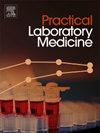探讨分析前处理对血清样品中神经元特异性烯醇化酶测定的影响
IF 1.3
Q3 MEDICAL LABORATORY TECHNOLOGY
引用次数: 0
摘要
目的探讨影响血清样本神经元特异性烯醇化酶(NSE)检测结果的前分析因素,选择最佳检测条件,降低NSE的假阳性率。方法采用罗氏e801电化学发光免疫分析法测定2022年9月至2024年12月在苏州大学附属第四医院体检的健康受试者血清NSE水平,包括门诊和住院患者。进一步分析了各种分析前因素对NSE阳性率的影响(判断nse16.3 ng/mL为NSE阳性)以及溶血指数(H)≥13的比例(H = 13相当于血红蛋白浓度为13 mg/dl)。结果本研究发现NSE阳性率及H≥13比例受溶血情况、样品运输方式、预离心保存时间、采血管品牌、离心条件等因素影响。然而,离心后储存时间对这些结果影响不大。结论采血后,采用箱式物流或人工运输等较轻的运输方式,最后一次采血后离心30 ~ 40 min或不超过1 H,使用B牌采血管在2100 g(加速4、减速6)、20℃下离心10 min, NSE阳性率和H≥13比例明显降低。在这些条件下,h<男性的NSE结果没有显著影响;6、H <;5.本文章由计算机程序翻译,如有差异,请以英文原文为准。
Exploring the impact of pre-analytical processes on the determination of neuron-specific enolase in serum samples
Objective
To explore pre-analysis factors affecting the results of neuron-specific enolase (NSE) testing of serum samples, select optimal testing conditions, and reduce the false-positive rate of NSE.
Methods
Serum NSE levels were measured using the Roche e801 electrochemiluminescence immunoassay in healthy participants who underwent physical examinations at the Fourth Affiliated Hospital of Soochow University from September 2022 to December 2024, including both outpatients and hospitalized patients. Further, we analyzed the effects of various pre-analytical factors on the NSE positivity rate (NSE>16.3 ng/mL was judged to be NSE-positive) and the proportion of hemolysis index (H) ≥13 (H = 13 was equivalent to hemoglobin concentration of 13 mg/dl).
Results
This study found that the positive rate of NSE and the H ≥ 13 proportion were influenced by factors such as hemolysis, the method of sample transportation, pre-centrifugation storage time, the brand of blood collection tube, and centrifugation conditions. However, post-centrifugation storage time had little effect on these results.
Conclusion
After blood collection, the NSE positive rate and the H ≥ 13 proportion significantly decreased using a gentler transportation method, such as a box logistics or manual transport, centrifuging within 30–40 min or no longer than 1 h at the latest post-collection, and centrifuging at 2100 g (acceleration 4, deceleration 6) and 20 °C for 10 min with brand B blood collection tubes. Under these conditions, there was no significant impact on NSE results for males with H < 6 and females with H < 5.
求助全文
通过发布文献求助,成功后即可免费获取论文全文。
去求助
来源期刊

Practical Laboratory Medicine
Health Professions-Radiological and Ultrasound Technology
CiteScore
3.50
自引率
0.00%
发文量
40
审稿时长
7 weeks
期刊介绍:
Practical Laboratory Medicine is a high-quality, peer-reviewed, international open-access journal publishing original research, new methods and critical evaluations, case reports and short papers in the fields of clinical chemistry and laboratory medicine. The objective of the journal is to provide practical information of immediate relevance to workers in clinical laboratories. The primary scope of the journal covers clinical chemistry, hematology, molecular biology and genetics relevant to laboratory medicine, microbiology, immunology, therapeutic drug monitoring and toxicology, laboratory management and informatics. We welcome papers which describe critical evaluations of biomarkers and their role in the diagnosis and treatment of clinically significant disease, validation of commercial and in-house IVD methods, method comparisons, interference reports, the development of new reagents and reference materials, reference range studies and regulatory compliance reports. Manuscripts describing the development of new methods applicable to laboratory medicine (including point-of-care testing) are particularly encouraged, even if preliminary or small scale.
 求助内容:
求助内容: 应助结果提醒方式:
应助结果提醒方式:


